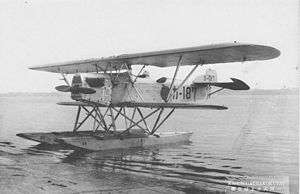Nakajima E2N
The Nakajima E2N was a Japanese reconnaissance aircraft of the inter-war years. It was a single-engine, two-seat, sesquiplane seaplane with twin main floats.
| E2N | |
|---|---|
 | |
| Role | Reconnaissance seaplane |
| Manufacturer | Nakajima Aircraft Company |
| Introduction | 1927 |
| Primary user | Imperial Japanese Navy |
| Produced | 1927-1929 |
| Number built | 80 |
Design and development
The E2N was developed in the 1920s for the Imperial Japanese Navy as a short range reconnaissance floatplane suitable for catapult launch from cruisers and battleships.[1] It was a wooden twin-float sesquiplane, carrying a crew of two in open cockpits and having folding wings. This layout gave better downwards view than the monoplanes proposed by Aichi and Yokosuka, and the design was selected becoming Japan's first locally designed shipboard reconnaissance seaplane.
Operational history
The E2N served with the Navy as the Nakajima Navy Type 15 Reconnaissance Floatplane (一五式水上偵察機). 80 examples were produced between 1927 and 1929 by Nakajima and Kawanishi; of these, two were bought for civil fishery patrol duties. The Navy machines were withdrawn from front-line units in the 1930s, being replaced by the Nakajima E4N, and either being reassigned to training duties or sold to civil buyers.
Variants
- E2N1 (Type 15-1 Reconnaissance Seaplane)
- Short-range reconnaissance aircraft.
- E2N2 (Type 15-2 Reconnaissance Seaplane)
- Trainer version with dual controls.
Specifications (E2N)
Data from Japanese Aircraft, 1910-1941[1]
General characteristics
- Crew: 2
- Length: 9.565 m (31 ft 5 in)
- Wingspan: 13.52 m (44 ft 4 in)
- Height: 3.688 m (12 ft 1 in)
- Wing area: 44 m2 (470 sq ft)
- Empty weight: 1,409 kg (3,106 lb)
- Gross weight: 1,950 kg (4,299 lb)
- Powerplant: × Mitsubishi Type Hi V-8 water-cooled piston engine, 220–250 kW (300–340 hp)
- Propellers: 2-bladed fixed-pitch wooden propeller
Performance
- Maximum speed: 172 km/h (107 mph, 93 kn)
- Endurance: 5 hours
- Time to altitude: 3,000 m (9,843 ft) in 31 minutes 37 seconds
- Wing loading: 44.3 kg/m2 (9.1 lb/sq ft)
- Power/mass: 0.12 kW/kg (0.07 hp/lb)
Armament
- Guns: 1 × flexible 7.7 mm (.303 in) machine gun
References
| Wikimedia Commons has media related to Nakajima E2N. |
Notes
- Mikesh and Abe 1990, pp. 223–224.
Bibliography
Mikesh, Robert C.; Shorzoe Abe (1990). Japanese Aircraft, 1910-1941. London: Putnam & Company Ltd. ISBN 0-85177-840-2.